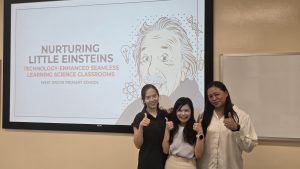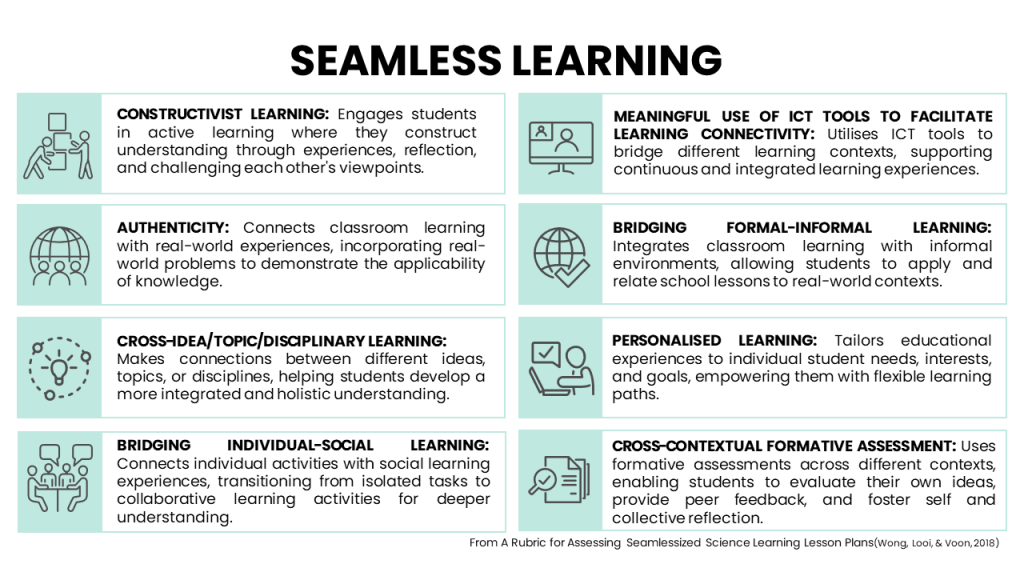Why Singapore’s English Teachers Should Embrace Singlish, Not Fight It
Is it time for Singaporean educators to embrace Singlish as a legitimate learning tool? What the Research […]
Read More
Contributed by Tan Si Hua, Rachael Fang Swee Sian and Nurhuda Amin from West Grove Primary School, for SingTeach Virtual Staff Lounge

The team comprises (from left to right) Rachael Fang Swee Sian, Tan Si Hua and Nurhuda Amin.
A central goal of science education is to enable students in their foundation years to appreciate the value of science and its application in their everyday lives, laying the groundwork for future pursuits of science learning. Realizing this goal necessitates that science classrooms provide students with learning experiences that leverage their interests and stimulate their curiosity as inquirers to explore and apply scientific concepts to phenomena related to their daily experiences and environment, going beyond learning facts and outcomes of scientific investigations (NGSS, 2013).
Seamless Learning (Wong, Looi, & Goh, 2019), which may be understood as the integration of experiences across formal and informal settings and the blending of individual and collaborative learning experiences in both physical and digital spaces through a continuous learning trajectory, supports learners in exploring and appreciating the role of science in their everyday lives and cultivates students’ habits of mind as budding inquirers.
To support teachers in implementing Seamless Learning experiences, Wong, Looi, and Voon (2018) developed a useful framework in the form of a Seamless Learning lesson design rubric, comprising eight design principles derived from a synthesis of Seamless literature (see Figure 1).

Figure 1. Eight Dimensions of Seamless Learning
For example, designing and viewing a learning experience through the lens of this framework for Primary 5 students on the topic of the water cycle, with the objective of helping students identify the roles of evaporation and condensation in the water cycle and recognize their importance, can look like this:
At lower levels of the Seamless Learning rubrics, learning experiences predominantly focus on the transmission of subject content on the water cycle rather than facilitating meaning-making through inquiry (Constructivism), with limited experiences to help students relate their daily experiences to the water cycle (Authenticity). Learning is largely confined to formal settings with little or no explicit connections made between what students learn in class about the water cycle and their everyday experiences, focusing on drill-and-practice assignments (Formal-Informal Learning). Cross-topic and disciplinary connections are primarily explained to students didactically (Cross-idea/topic/disciplinary Connections).
Learning activities predominantly involve students working independently, with few opportunities for collaboration (Individual-Social). Additionally, activities are mainly directed by teachers, with content primarily adhering closely to curriculum-based learning goals specified in the syllabus (Personalized Learning). Formative assessment is primarily driven by teachers, involving the design and assessment of students with tools like quizzes and performance tasks (Cross-contextual Formative Assessment). Little technology is applied in isolated learning activities without enhancing scientific inquiry. For example, students may watch an online explainer on the water cycle without follow-up activities to deepen their understanding or connect to other learning experiences (Meaningful Use of ICT Tools).
At higher levels of the Seamless Learning rubrics, students are provided with a range of inquiry learning experiences, such as hands-on activities, intentionally bridged to encourage the construction of scientific knowledge on the water cycle through personal reflections and by challenging their peers’ viewpoints (Constructivism). Students have the opportunity to observe and manipulate real-world environments, encouraging the generation of new knowledge. For example, teachers can guide students in discussing real-world challenges related to clean water and sanitation by exploring the UN Sustainable Development Goals and Singapore’s water story to help students appreciate water as a precious resource, augmented with a visit to the NEWater plant, highlighting how science and technology have transformed the world and improved our lives. Additionally, teachers can introduce inventions such as fog catchers and mist cooling systems to help students appreciate the meaningful applications of evaporation and condensation in everyday phenomena (Authenticity).
In more advanced Seamless Learning experiences, teachers intentionally bridge students’ cross-topic and disciplinary connections. For instance, students conduct water audits to investigate water wastage costs using rates learned in Mathematics, and explore hydroelectric power generation for the scientific theme on Energy (Cross-idea/topic/disciplinary Connections). Students have the opportunity to work both individually and collaboratively throughout inquiry learning experiences. For example, to ensure students complete pre-reading materials and acquire foundational knowledge about the water cycle, teachers first administer an individual quiz. Teachers then have students discuss and finalize their answers in groups, followed by a class discussion to address strengths, gaps, and misconceptions, thereby connecting individual and collaborative learning experiences (Individual-Social).
Throughout the seamless learning process, key technological applications of ICT tools are integrated to support the shift of the learning culture to one that is more participative, reflective, and connected by enhancing student engagement, deepening learning, and giving greater student agency (Meaningful Use of ICT Tools). Students can set and pursue both curriculum-based and interest-based learning goals and experiences (Personalized Learning). For example, the exponential rise of generative AI can create child-friendly learning companion chatbots like School.ai, which provide prompts, hints, and introduce related topics, encouraging students to pursue personalized learning pathways and explore interest-based subjects such as the impact of water pollution beyond the water cycle curriculum. Technology can also enhance formative assessment processes, involving students playing a more active role in reflecting on their own understanding through self and peer assessments as a budding community of practice of young inquirers (Cross-contextual Formative Assessment), through both formal and informal settings (Formal-Informal Learning). For example, students can engage in knowledge building and peer feedback through online discussions to connect classroom learning with observations on the water cycle made in daily experiences.
One major takeaway from implementing Seamless Learning is witnessing firsthand how students can be a tremendous source of progressive approaches to science teaching and learning. When teachers skillfully bridge students’ inquiry experiences and intentionally invite students as learning partners to actively co-construct the social and technological learning contexts, students demonstrate a propensity to contribute meaningfully to the collective intelligence of the community of practice as budding inquirers, thereby deepening inquiry. For example, tapping into students’ curiosity and interest in extreme environmental temperatures, elicited through online discussions, has spurred cross-topic connections on climate change and its impact on water cycles. Our team is looking forward to embracing Seamless Learning as an educational philosophy, cultivating students’ habits of mind from their formative years for science in life, learning, and citizenship, nurturing the little Einsteins of tomorrow.
“When teachers skillfully bridge students’ inquiry experiences and intentionally invite students as learning partners to actively co-construct the social and technological learning contexts, students demonstrate a propensity to contribute meaningfully to the collective intelligence of the community of practice as budding inquirers, thereby deepening inquiry.”
References
NGSS Lead States. (2013). Next generation science standards: For states, by states. National Academies Press.
Wong, L.H., Looi, C.K., & Voon, X. P. (2018). A rubric for assessing seamlessized Science learning lesson plans. Workshop proceedings of 26th international conference on computers in education (pp. 761–766), Manila, Philippines.
Wong, L. H., & Looi, C. K. (2019). The conceptual niche of seamless learning: An invitation to dialogue. Seamless learning: Perspectives, challenges and opportunities, 3-27.